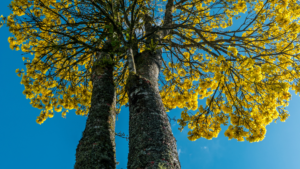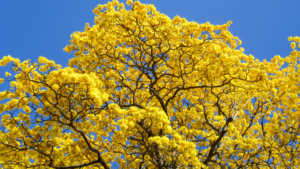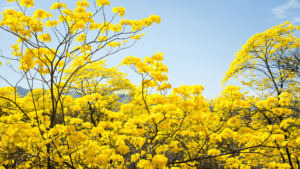
If you are looking for a spectacular natural phenomenon that will take your breath away, you might want to visit Ecuador during the flowering of guayacán trees. These majestic hardwood trees belong to the Bignoniaceae family and can grow up to 20 meters tall. They are adapted to the tropical dry forests of these countries, where they shed their leaves during the long dry season to conserve water.
If you love nature and beauty, you don't want to miss the flowering of guayacán trees in Ecuador.
But when the first rains arrive, usually between January and March, something magical happens. The guayacán trees burst into bloom, covering their branches with clusters of bright yellow flowers that contrast with the red soil and blue sky. The whole forest turns into a sea of gold for a few days, attracting thousands of visitors who want to witness this rare and beautiful spectacle.
The flowering of guayacán trees is not only a feast for the eyes, but also for other senses. The flowers have a sweet fragrance that fills the air and attracts bees, butterflies and hummingbirds that pollinate them. The flowers also produce nectar that locals collect and use to make honey and beverages. And when the flowers fall to the ground, they create a soft carpet that crunches under your feet.
The flowering of guayacán trees is also a sign of hope and renewal for many people who live in these regions. Some locals believe that the yellow tabebuia tree (Tabebuia chrysantha), which is one of the species of guayacán found in Ecuador, predicts the arrival of the green season or rainy season. They say that it blooms one month before the rains start, bringing life and prosperity to their lands.
If you want to experience this amazing natural event yourself, you need to plan ahead and be flexible. The flowering of guayacán trees depends on several factors such as temperature, rainfall and soil moisture. It can vary from year to year and from place to place. Sometimes it happens all at once in a large area; sometimes it happens gradually in smaller patches. Sometimes it lasts for a week; sometimes only for a day or two.
One of the best places to see it is Mangahurco, a remote town in southern Ecuador near the border with Peru. There are about 40,000 hectares (almost 100,000 acres) of guayacán forest surrounding Mangahurco and two other nearby towns: Bolaspambas and Cazaderos. You can get there by car or bus from Loja or Machala (the nearest cities), but be prepared for dirt roads and limited services.
You will surely be amazed by this natural wonder that showcases nature’s beauty, diversity, resilience, and creativity. Don’t miss this opportunity to see one of nature’s most stunning displays: The flowering of guayacán trees!







No Comments